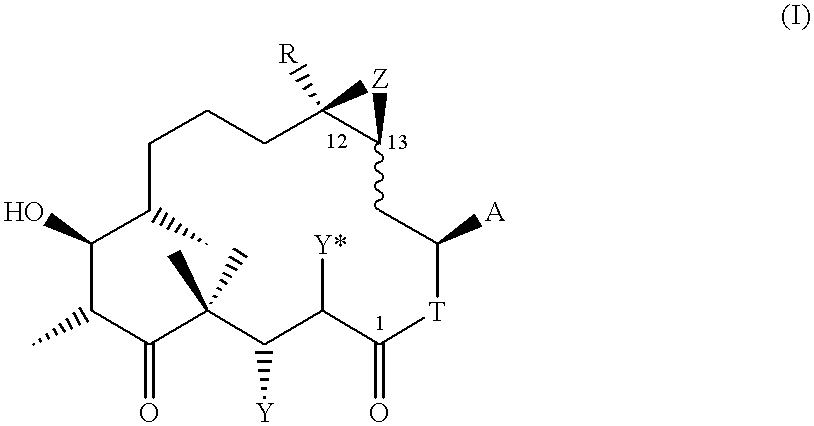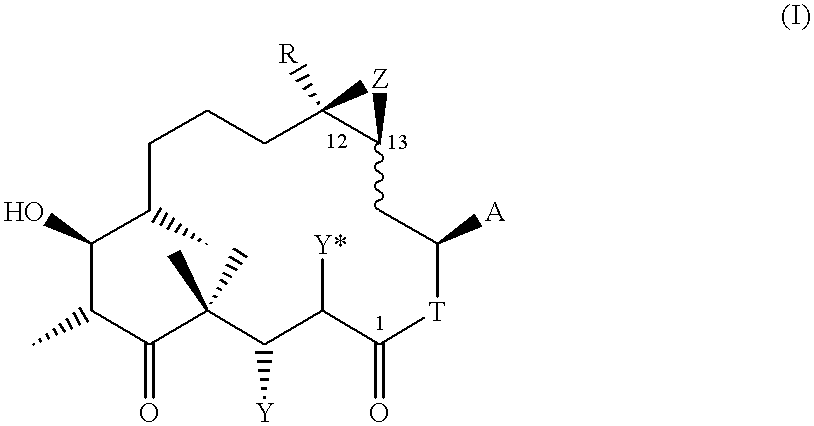Epothilone derivatives and their use as antitumor agents
a technology of epothilone derivatives and antitumor agents, which is applied in the direction of heterocyclic compound active ingredients, biocide, drug compositions, etc., can solve the problems of ineffective treatment of a series of tumours, low therapeutic index, and difficult preparation of pharmaceutical formulations
- Summary
- Abstract
- Description
- Claims
- Application Information
AI Technical Summary
Problems solved by technology
Method used
Image
Examples
example 1
4,8-Dihydroxy-5,5,7,9,13-pentamethyl-16-(2-methyl-benzothiazol-5-yl)-oxacyclohexadec-13-en-2,6-dione (19)
##STR38##
0.175 ml of trifluoroacetic acid are added dropwise over the course of 5 minutes at -20.degree. C. to a solution of 0.041 g of the protected lactone 18 [see example (1k)] in 0.7 ml of CH.sub.2 Cl.sub.2, and the solution is subsequently stirred for 1 hour at 0.degree. C. The solution is then concentrated by evaporation, and the residue obtained is purified by FC in CH.sub.2 Cl.sub.2 / methanol 100 / 1.fwdarw.100 / 2. 0.028 g of 19 are obtained as a colourless resin.
ESI-MS: 502 (M+H).sup.+. .sup.1 H-NMR (CDCl.sub.3, 300 MHz), .delta. (ppm vs. TMS): 7.99 (s, 1H); 7.80 (d, 1H); 7.36 (d, 1H); 5.92 (d,d, 1H); 5.15-5.26 (m, 1H); 4.21 (d,d, 1H); 3.75 (t, 1H); 3.1-3.23 (m, 1H); 2.84 (s, 3H); 1.70 (s, .about.3H). [.alpha.].sub.D =-77.39.degree. (c=0.115 in CHCl.sub.3).
The starting materials are produced as follows:
(1a) Aldehyde 1 ##STR39##
21.09 of N-bromosuccinimide are added to a solu...
example 2
4,8-dihydroxy-5,5,7,9,13-pentamethyl-16-(2-methyl-benzothiazol-6-yl)-oxacyclohexadec-13-en-2,6-dione (deprotected lactone 27)
##STR52##
preparation of 27 takes place analogously to that of 19 g (example 1) from 0.144 g of 26 [example 2(m)].
ESI-MS: 502 (M+H).sup.+. .sup.1 H-NMR (CDCl.sub.3, 200 MHz), .delta. (ppm vs. TMS): 7.92 (d, 1H); 7.83 (d, 1H); 7.44 (d,d, 1H); 5.86 (d,d, 1H); 5.14-5.25 (m, 1H); 4.08 (d,d, 1H); 3.74 (t, 1H); 3.16 (m, 1H); 2.82 (s, 3H); 1.67 (s, .about.3H); 1.26 (s, 3H); 1.19 g (d, 3H); 1.03 (s) and 1.01 (s, together 6H). [.alpha.].sub.D =-63,75.degree. (c=0.4 in CHCl.sub.3).
The starting materials are produced as follows:
(2a) 2-bromo-4-methyl-thioacetanilide ##STR53##
2-bromo-4-methyl-acetanilide (Maybridge) is added to a suspension of 24.74 g of P.sub.2 S.sub.5 in 250 ml of benzene and heated under reflux for 3 hours. After cooling to room temperature, the mixture is filtered and the residue of filtration washed with ether. The combined filtrates are extracted with...
examples 1 / 3
EXAMPLES 1 / 3 ALTERNATIVE ROUTE
##STR69##
To a solution of 1.001 g of 96 in 10 ml of THF were added 4.2 ml of a 0.5M solution of BBN in THF (Aldrich) under Ar and the mixture was stirred at RT for 4 h (solution A). In a separate flask 0.679 g of vinyl iodide 5 were added to a mixture of 0.934 g Of CS.sub.2 CO.sub.3, 0.117 g of Ph.sub.3 As, 0.140 g of PdCl.sub.2 (dppf), and 0.310 ml of water in 10 ml of DMF (solution B). Solution B was cooled to -10.degree. C. and then solution A was added. Tho reaction mixture was allowed to warm to RT and stirred at RT for 21h, when 50 ml of water were added. The aqueous solution was then extracted three times with 50 ml of AcOEt each and the combined organic extracts were once washed with 50 ml of water. After drying over Na.sub.2 SO.sub.4 and evaporation of solvent the residue was purified by FC in hexane / AcOEt 9 / 1 (2 runs) to provide 1.137 g of 30.
ESI-MS: 876 (M+H). .sup.1 H-NMR (CDCl.sub.3, 500 MHz): .delta. (ppm vs. TMS )=7.86 (s, 1H); 7.73 (d, 1...
PUM
| Property | Measurement | Unit |
|---|---|---|
| Volume | aaaaa | aaaaa |
Abstract
Description
Claims
Application Information
 Login to View More
Login to View More - R&D
- Intellectual Property
- Life Sciences
- Materials
- Tech Scout
- Unparalleled Data Quality
- Higher Quality Content
- 60% Fewer Hallucinations
Browse by: Latest US Patents, China's latest patents, Technical Efficacy Thesaurus, Application Domain, Technology Topic, Popular Technical Reports.
© 2025 PatSnap. All rights reserved.Legal|Privacy policy|Modern Slavery Act Transparency Statement|Sitemap|About US| Contact US: help@patsnap.com



